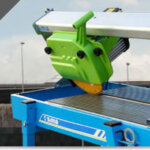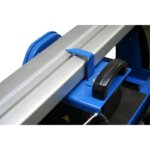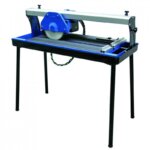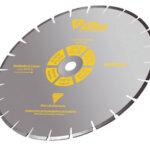Except for being round in shape and spinning on the arbor of a saw, masonry saw blades are different from other types of blades in practically every respect. From what they are used for, to how they are made; from how they work to the different types of masonry saw blades that exist – if your project calls for a masonry saw blade, know that not just any old blade will do.
Contents
What masonry saw blades are used for
The reason masonry saw blades are so different from other blades is because they are used to cut through very different materials. A normal saw blade for a circular saw or table saw is designed to cut through wood and maybe some types of plastic. Masonry saw blades, on the other hand, are made to cut through some of the hardest materials known to man: stone, granite, porcelain, brick, concrete, and even reinforced concrete containing steel rebar! They can also be used to cut through tile on a tile saw.
Obviously, that means that masonry saw blades must be made specifically to cut through these challenging materials.
How masonry saw blades are made
The basic composition of a masonry saw blade or tile saw blade is a round steel core, which looks similar to any other saw blade but without any sharp teeth, with the outer edge coated in a mixture of diamond particles and soft metal. The edge may be smooth or it may contain square notches, but it doesn’t have any sharp teeth like other saw blades do.
To make masonry saw blades, manufacturers start with a bare core and use special equipment to apply the diamond particles to the outer edge. A soft metal called “bond” is used to hold the diamonds in place.
How masonry saw blades work
Those diamond particles are what do the heavy lifting in masonry saw blades. Unlike other blades, whose sharp teeth cut through wood, masonry blades grind through stone and similar materials. Because diamond is such a hard mineral, it is able to grind through very tough materials. As it does, the particles get worn down and aren’t sharp enough to continue the job. This is why the bond on the blade is made of soft metal; it gets worn down faster than the diamond, so that fresh diamond particles are always exposed and ready to work.
Different types of masonry saw blades
Reinforced concrete is nothing like marble, and neither is anything like porcelain. Not all masonry materials are equal, which means that not all masonry saw blades are the same, either.
First, these blades can be broadly classified as dry cut or wet cut blades. The vast majority are for wet cutting, which means that water is used to cool the blade during cutting. Almost all masonry and tile saws have a built-in water cooling feature. Dry cutting blades don’t use water, so they usually have notches to promote air cooling. Dry blades can be used for wet cutting, but wet blades can NEVER be used for dry cutting.
Apart from that, there are different ratios of diamond to bond, and also different grit levels and different types of metal used for the bond. This all depends on the properties of the material being cut. Very abrasive materials that are not very hard, for example, should have a harder metal bond so that it only wears down as fast as it needs to, extending the life of the blade.





